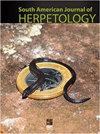水生植物对巴西南部沙丘蜥蜴营养生态的贡献
IF 0.7
4区 生物学
Q4 ZOOLOGY
引用次数: 1
摘要
摘要营养补贴是一个生态过程,包括营养物质在相邻栖息地之间的转移,允许几个物种占据生产力较低的栖息地。研究了巴西南部临时池塘水生植物对沙蜥蜴个体维持的营养补贴。这种蜥蜴是一种坐等捕食者,仅限于沿海沙丘。由于这些沙丘出现在临时池塘的马赛克中,我们假设存在来自邻近水生栖息地的蜥蜴的营养/能量依赖。我们的评估是基于碳和氮稳定同位素分析,以及整个淹没周期取样的蜥蜴肠道含量分析。胃内容物在被捕食的猎物组成上没有季节变化。然而,我们发现了猎物群体组成的变化。双翅目的体积贡献随着淹没等级的增加而增加(增加= 5%;峰值= 61%)。碳氮稳定同位素比值表明,枕螺营养网主要由陆源维持。同位素比值也表明水生生物对组织形成有贡献,但是,尽管其在淹没过程中有增加的趋势(10.7-13.3%),但这一趋势缺乏统计支持。研究结果表明,该物种的种群数量部分依赖于水生资源的营养补贴,任何保护计划都应考虑到临时池塘等非栖息地的保护。本文章由计算机程序翻译,如有差异,请以英文原文为准。
The Contribution of Aquatic Plants to the Trophic Ecology of a Sand Dune Lizard in Southern Brazil
Abstract. Trophic subsidy is an ecological process consisting in the transference of nutrients between adjacent habitats, allowing the occupancy of less productive habitats by several species. We tested for the existence of trophic subsidy provided by aquatic plants of temporary ponds in maintaining individuals of the sand dune lizard Liolaemus occipitalis in southern Brazil. This lizard is a sit-and-wait predator restricted to coastal sand dunes. As these sand dunes occur in a mosaic of temporary ponds, we hypothesized the existence of a nutritional/energetic dependence of lizards from adjacent aquatic habitats. Our evaluation was based on carbon and nitrogen stable isotope analysis in association with gut content analysis of lizards sampled along an entire inundation cycle. Stomach contents revealed no seasonal variation in consumed prey item composition. Nevertheless, we detected changes in prey group composition. The volumetric contribution of Diptera increased over inundation classes (increase = 5%; peak = 61%). Carbon and nitrogen stable isotope ratios indicated that the L. occipitalis trophic web is mainly maintained by terrestrial sources. Isotope ratios also indicated the existence of aquatic contributions to tissue formation, but, despite its tendency to increase over the inundation process (10.7–13.3%), this trend lacks statistical support. We conclude that the studied population of L. occipitalis partially depends on trophic subsidy from aquatic sources and that any conservation plan for this endangered lizard species should take into account the preservation of non-habitats like temporary ponds.
求助全文
通过发布文献求助,成功后即可免费获取论文全文。
去求助
来源期刊
CiteScore
1.50
自引率
0.00%
发文量
10
期刊介绍:
The South American Journal of Herpetology (SAJH) is an international journal published by the Brazilian Society of Herpetology that aims to provide an effective medium of communication for the international herpetological community. SAJH publishes peer-reviewed original contributions on all subjects related to the biology of amphibians and reptiles, including descriptive, comparative, inferential, and experimental studies and taxa from anywhere in the world, as well as theoretical studies that explore principles and methods.

 求助内容:
求助内容: 应助结果提醒方式:
应助结果提醒方式:


